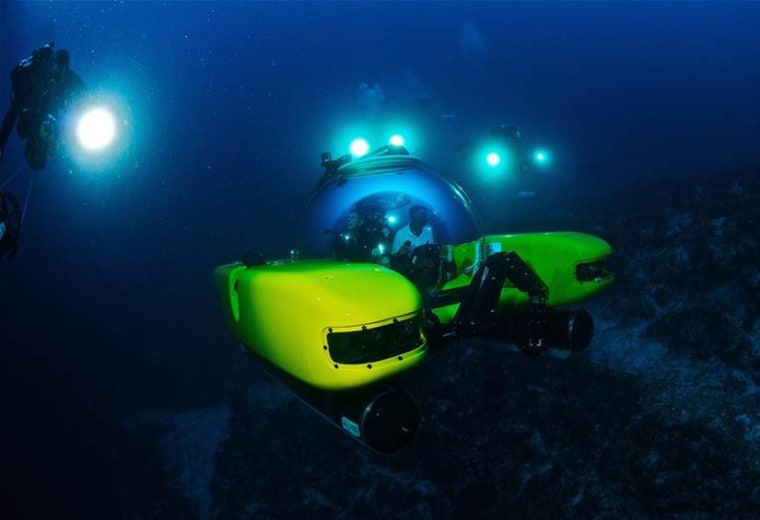Conditions at the deepest point of the ocean, 36,000 feet down in the Pacific's Mariana Trench, are so intense that the only manned submersible to make it there was the Trieste bathyscaphe, and that was in 1960.
Enter Triton Submarines CEO Bruce Jones. His team just announced that they've developed new technology for a submersible to take humans 36,000 feet below the ocean's surface to the deepest of the deep.
"This is a real commercial, scientific work vehicle that we expect to get a lot of use," said Jones, who has been in the submarine business for 20 years. "It's not, 'Let's go to the bottom of the ocean one time and then give it to a museum to put on a shelf."
The deep-water submersibles his company currently makes for yacht owners and scientists are certified to go as far as 3,300 feet underwater.
The design for the new vessel, called the Triton 36,000, will be based on the Triton series of submersibles made by Triton Submarines, a subsidiary of U.S. Submarines. Instead of using acrylic for the passenger compartment, they plan to use thick glass shaped into a sphere. They will use a newly developed technique created by San Diego-based Rayotek Scientific, a glassmaker whose long client list includes Boeing, DuPont, 3M and NASA.
Borosilicate glass has advantages over synthetics.
"Glass under compression gets stronger," said Rayotek CEO Bill Raggio. "You can hire some giant squid to come over with a sledgehammer and just start bashing away on that glass sphere. And it won't hurt it."
Slideshow: Military's Top 10 Ships
Materials expand and contract at different rates, so metal and glass joined together can create structural problems in the deep. To avoid that, Rayotek came up with a novel and proprietary technique to turn the glass into a sphere. Raggio said they're working on patenting it and can't share the details.
"The whole concept is very simple," Raggio said. "When you read the patent, you're going to think, 'Oh man, why didn't I think of that?'"
The plan for the Triton 36,000 is to seat three people — a pilot and two passengers. The hemispheres of the pressure hull will have a seal that can be removed for entering and exiting. Once people are inside, the sphere is resealed similar to the way a fighter pilot is protected by a dome that comes down over the cockpit.
"They call it the pressure boundary," said Raggio. "It's the boundary between you and instant death."
With such high risks, the glass submersible will undergo extensive testing in a chamber first to make sure it can withstand at least one and a quarter times the intended depth.
"You don't jump in and say, 'How deep can we go?'" Jones said. "We go gradually."
He also pointed out that modern submarine travel has a solid safety record.
The Triton Submarines submersible differs from other projects. Director James Cameron and mogul Richard Branson are financing other vehicles to return to the deep.
James Cameron's commissioned submarine will be made from composite materials and powered with an electric motor. Richard Branson's one-person submarine is made from carbon fiber, titanium, and has a quartz viewing dome. His sub will use hydrodynamic forces to "fly" underwater. That project is expected to cost $10 million.
Currently the Triton 36,000 is in the design and engineering stage, Jones said. He's also in discussions with potential clients, and is confident that the cost per three-seater submersible will be in the $15 million range, far less than the $60 million he said it costs to make a manned submarine that can go 20,000 feet.
Michael Buckingham is a distinguished professor at Scripps Institution of Oceanography specializing in marine acoustics. His research group sends small, unmanned spherical glass submersibles equipped with sensors 29,500 feet deep underwater.
"In fabricating the sphere, you have to be very careful in this application to not get any air bubbles in it," he said.
Those flaws could be disastrous, Buckingham explained. So far, though, the material has served his group well.
"Glass was a good choice in our case. I hope it's a good choice in their case," he said.
But Captain Don Walsh, USN (Ret.), who was aboard the Trieste with oceanographer Jacques Piccard in 1960, cautions glass can also be a complicated component.
"[Glass is] very very strong but also a lot of its characteristics aren't understood very well," he said. Walsh continues to consult on deep-ocean projects and was in California recently meeting with Branson's team and the X Prize Foundation.
"It's a new frontier in material science," he said.
